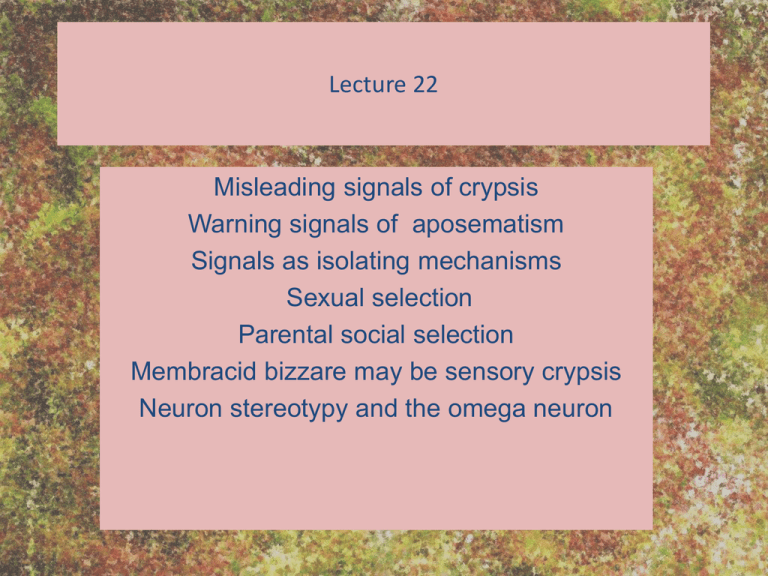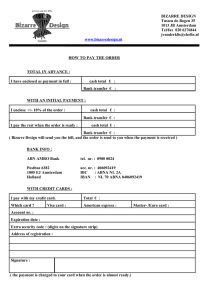
Lecture 22
Misleading signals of crypsis
Warning signals of aposematism
Signals as isolating mechanisms
Sexual selection
Parental social selection
Membracid bizzare may be sensory crypsis
Neuron stereotypy and the omega neuron
Male stalked eye fly
Papua New Guinea
(PNG)
Exhibit sexual
dimorphism
Males gain access to
mates
by defending resources
Stalked eye lengths are
important in rivalry
Some morphology just seems bizarre.
This tail
is part of a bizarre
display. Why
does it seem
bizarre? Because
natural selection
should improve
flight, not detract
from it. How could
natural selection
favour survival
and reproduction
in individuals that
fly badly?
Euplectes
long-tailed
widow bird
PNG
bird of paradise
Lecture 22
National
Geographic
Beautiful but bizarre
Signals are transmitted
information. The bodies of
animals are used to
communicate with others of
their species. And body form
is selected as the basis of a
signal or display; stereotyped
movements of specially
modified body parts become
a display: a signal between a
sender and receiver.
Sometimes an animal's body
is selected to NOT send
signals or more precisely, to
'misinform': cryptic
patterning and coloration is
really the absence of signals.
Many animal bodies involve
crypsis combined with an
absence of movement.
Wikkipedia
red-wattled lapwing
Both eggs and hatchlings blend into the substratum and
are difficult to detect visually.
Dita Klimas
Dita Klimas
glass
katydid
Phlugis sp.
Smaller majority website
Piotr Naskrecki
Aposematic warning coloration
The body may also be
selected to signal a
warning: an honest
warning in a coral snake
that this creature is truly
dangerous and should be
left alone; a dishonest
warning in a mimic of the
venomous (noxious)
model.
Red and yellow kill a fellow
Red and black venom lack
Pardalota reimeri
An oedipodine crackling locust on an abandoned asphalt road
surface, near Lake Superior. This coloration is certainly not bizarre, it
is expected, i.e., is produced by natural selection favouring beneficial
markings.
Mot mot
Cryptic and aposematic body
forms are reasonably seen as
the product of natural, not
sexual or social selection.
Long tails are bizarre and
seem unlikely to contribute
aerodynamically to flight.
Widow bird
Why do these birds have long tails?
And surely this tail is
bizarre for a flying
animal.
Signals as isolating mechanisms
•
The other day I talked about the evolution of diagnostic genitalia. Why
should such body parts be distinctive, so distinctive that by genitalia alone
one can diagnose species? Taxonomists use such distinctions to tell
species – perhaps the animals tell too? Perhaps the distinctively unique
male and female claspers, manipulators of sperm etc. in damselflies
evolved to make sure that mating occurs only within the species, i.e., the
genitalia isolate species. Isolation might be adaptive because there are
costs to mating with the wrong species: the resulting hybrid offspring would
receive an unusual mix of genes from the parents and be less likely to
survive and reproduce. Offspring of interspecific matings would be at a
disadvantage against both parental species. A male and female mating
outside their species waste resources. For the longest time, thinking about
such differences was focused on isolating mechanisms between species:
features that were species distinctive were seen as evolving as isolating
mechanisms by natural selection.
• Males and females engaged in mating behaviour exchanged signals
using structures, either on the body itself (genitalia), or removed from
the body itself, i.e., sound and vibration signals, chemical signals, light
waves.
• Signals exchanged between mates: songs/calls of birds, frogs and
insects, flashes of fireflies are all remarkably species diagnostic. These
aspects of communication were seen as evolving to promote correct
species to species matings. A firefly female in the grass only
responded to the correct species-specific flash pattern of the male
flying above. A cricket male calling from a burrow attracted only
females of his species to localize his position in the dark and mate.
Cricket, katydid, grasshoppers, frogs, birds were all making diagnostic
calls because of species isolation. The function of species-distinctive
forms, their adaptive basis, was maintenance of species integrity.
• There is another way of explaining the evolution of species-distinctive
body parts: not by natural but by sexual selection. This is selection arising
from premating choices that occur in two possible ways: either as one sex
fights for the other or as one sex chooses the other. Fighting, rivalry,
threat, ways of settling the issue of mate access occurs usually between
males: it involves morphological features such as horns serving as threat
signals and weapons; but it can involve things like stalked eye width.
Rivalry between males for access to mates: frilled lizards
•
Choice on the other hand is usually imposed by
females and leads males to compete intensely to gain
the female's attention. Male bodies become altered by
adornment that female’s notice. The sensory
capacities of the female channel the sort of display that
evolves (sensory drive). If she sees red better than
blue then the feathers of a male's display will do better
affecting her choice if they are red-pigmented. Body
surface features become elaborately altered to
promote being chosen. These changes often will be at
odds with body functions shaped by natural selection.
The tail of a widow bird male increases his success in
mating at a cost to his ability to fly (Balmford et al.
1993). Other male birds fly better because they are
closer to the optimum dictated by natural selection,
but if the females pick the longer tailed bird, he is NET
better in the competition for mates and his kind of
geneholder increases in the population.
• There is an arbitrariness in signals. What evolves under the
reproductive isolation hypothesis doesn't matter: it just has to be
different to keep the species separate and encode the right
information. The same arbitrariness is present in sexually selected
mate choice by females: it doesn't matter if one female prefers red
and yellow plumage marks on the carpal (elbows) of the male (redwing blackbird) or tail length (widow birds). Distinctiveness must be
achieved for species isolation. Distinctiveness is a byproduct of
Fisherian runaway selection in the case of female imposed sexual
selection.
•
• The prevailing view now as to why there are diagnostic genitalia,
and diagnostic acoustic and visual displays: has to do with arbitrary
features being seized upon and rapidly elaborated by female
preferences operating within a species (just as indicated in the
argument advanced by Eberhard). The selection occurs
independently and the features rapidly diverge along separate
paths. So because females arbitrarily respond positively, i.e.,
'choose' a long tail rather than carpal elbow plumage this is what is
elaborated as a signal mediating mating pairing. Females with the
genetic basis for choosing long tails have sons with longer tails who
in turn are more preferred within the population: this is runaway
sexual selection. It may run counter to natural selection: tail length
compromises naturally selected features of tails: "Tails provide lift
during take-off and flight and act as a rudder for aerial turns.
Elongation of the tail for display purposes increases the drag on the
flying bird and greatly reduces agility, maneuverability, and flight
speed." (Bradbury & Vehrencamp, p. 552).
•
Source reading: Balmford, A. et al. 1993. Aerodynamics and the
evolution of long tails in birds. Nature 361: 628-631.
•
•
It is the male who must bear the cost of altering his flight
ability to please the female. Sexual dimorphism is a part
of sexual selection by female choice: males (typically) the
sex least in demand, wind up having to compromise their
naturally selected features.
from their abstract: Regarding “...Darwin’s suggestion that
female choice for ornate males may account for the
evolution of long tails in birds.” “We have integrated
aerodynamics theory with comparative data on sexual
dimorphism in tail length to evaluate the flight costs of
different forms of tail elongation [in various species of
bird]. We report here that long tails with shallow forks are
aerodynamically optimal, exhibit correspondingly low
sexual dimorphism and may therefore have evolved under
natural selection. Other long-tail types impair flight and
show greater sexual dimorphism ...”
Parental choice can impose selection too and
create signals that may seem bizarre though
perhaps carrying less cost than display
plumage.
S.R. Pryke
Gouldian finch chick
begging: gape marks are
signals selected to achieve
parental attention as chicks
compete for food. They are
produced by the choices
being made by the parents.
Coot
Wikki
Another example of parental choice creating a body form but this one
perhaps with more obvious costs.
Lyon B.E., Eadie J.M., Hamilton L.D. 1994.
Parental choice selects for ornamental
plumage in Amercian coot chicks. Nature
371: 240-243.
The bizarre Membracidae
•
Enchenopa binotata, a
treehopper species on black
locust that exhibits parental
care and elaborate vibrational
substratum species-specific
signalling.
Do they mimic thorns of the
black locust?
Sculpture Alfred Keller
Berlin Nature Museum
A bizarre pronotum
Morphological diversity in treehopper pronota
Crypsis and sensory
diversity. There is no
sexual dimorphism
involved in these
bizarre pronotal
differences. So they
seem not to be the
product of sexual
selection.
Could they actually
be cryptic but it is not
apparent to us
because we have
different sensory
capacities than the
predators whose eyes
were the basis of this
selection?
B Prud’homme et al. Nature 473, 83-86 (2011) doi:10.1038/nature09977










